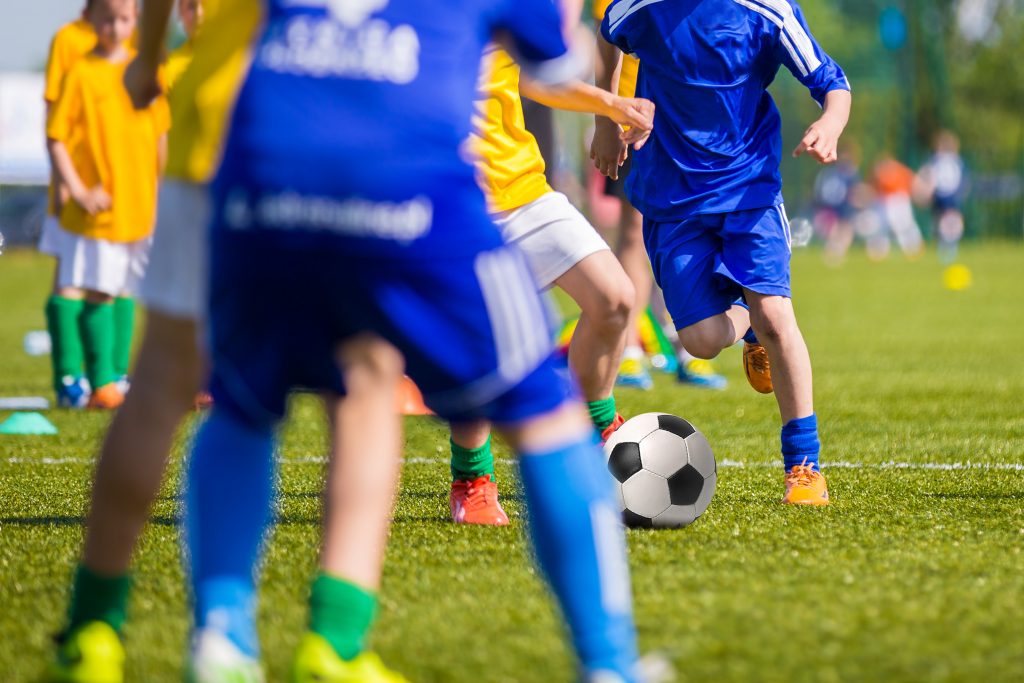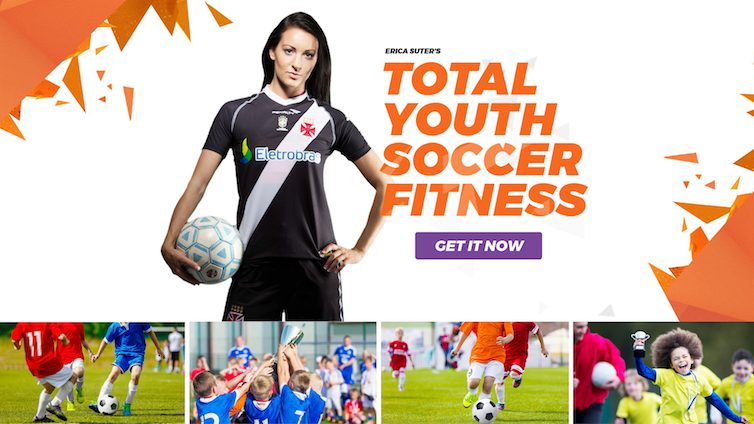I’ve got a guest post from Baltimore based strength & conditioning coach, Erica Suter today. She’s someone I respect a lot not only for her writing prowess (she gives me a run for my money with Lord of the Rings references), but also for her steadfastness in sticking to her guns.
She could easily train professional athletes given her own athletic background, but more to the point because she’s a gifted coach.
However, her preference is to work with youth athletes
And she crushes.
I am always impressed with Erica’s content and commitment to serving our younger generation of athletes. She’s recently released her first product – Total Youth Soccer Fitness – and it’s fantastic.
It’s really a manual for all young athletes and not just soccer, and I think it does a superb job at bringing the pendulum back to the middle. It provides a detailed strength & conditioning component, of course, but emphasizes something sorely lacking in today’s culture…
….fun!
It’s on sale for $67 for the next three days and then jumps to it’s full price of $97. Coaches, parents, Nazguls, act quickly. You won’t be disappointed. Get it HERE.

The Problems With Youth Fitness (With Solutions)
Besides J.R.R. Tolkien book themes, snowboarding trips, and triple shots of espresso, nothing lights me up more than youth fitness.
After seven years of coaching kids, I guess I have a lot to say on the topic. As a self-proclaimed introvert, my extrovert side certainly shines through any time strength and conditioning for youth athletes comes up. Here’s a common conversation I’ve had countless times:
Parent: “Can you do conditioning for my 10-year-old?”
Me: “Like take them to the playground?”
Parent: “No, like suicides, laps, timed miles.”
Me: “Find another coach.”
(hangs up phone abruptly)
Okay, okay, maybe it’s not this dramatic, but you get my point.
Look. I love working with kids. There’s something magical about teaching a beginner the ropes of training and seeing them all the way through their athletic development to college and beyond.
But what I love more is teaching everyone involved in youth fitness that there are safe, fun, and effective ways to get kids better at their sport.
Still, some of these kids are in the wrong training hands. With overuse injuries, sports drop-out rates, lack of passion for sport, and sedentary lifestyles on the rise, I fear the future of the youth athlete.
More often than not, kids are trained wrong.
Whether a coach is misinformed, parents are Googling Messi workouts for their 10-year-old too much, or a new trainer wants to grow his social media following, kids are doing some ridiculous things (most that are unsafe) in the gym and on the field.
With that said, besides sitting at the DMV, there’s nothing worse than perusing Instagram and seeing these things:
– an 8-year-old sprinting up a hill carrying a medicine ball.
– a 10-year-old attached to a sled while dribbling through cones.
– a team of 8-year-olds running sprints around the field as punishment.
– a high school kid doing CrossFit box jumps without mastering jumping and landing mechanics.
Of course, I could make a laundry list here, but instead of complaining, I want to shed light on some of the biggest problems in youth fitness as well as provide actionable solutions.
Let’s do this:
1. People Aren’t Keeping Youth Fitness Simple.
When it comes to training kids, I like to be guided by this mantra: keep it simple, stupid.
A training session with kids should focus on 1-2 skills or performance components you want them to improve, then progress from there. There’s no need to be all over the place and complicate things. If you’re a coach who is trying to teach speed and jumps right into the speed resistance bands, harnesses, sleds, and unicorns to look flashy, who the hell are you?
Worse yet, the kid’s reps are terrible, form is weak, and coordination is non-existent.
So.
I have an idea: tell kids to skip or march and see the whacky coordination show. If they can’t do these simple tasks, what makes you think their linear and multi-directional mechanics will be clean?
Besides asking yourself what skill you want to teach that day, I’d also argue you should ask yourself: “am I developing athletes or social media stars?” before you jump to posting flashy videos on your Instagram.
*drops mic*
2. Youth Athletes Don’t Learn the Basic Motor Skills Enough.
Speaking of keeping it simple, always start with the basics.
Here are some staples to my youth fitness programs:
– Balance
– Contralateral Coordination
– Core Stability
– Jumping and Landing Mechanics
– Athletic Stance
What’s funny is, these basics set youth athletes up for the “cool” things they get to do later on in their development, like power cleans, deadlifts, pull-ups, lunge variations, and more. Behind every healthy, athletic youth athlete is someone who masters the basics.
Relentlessly.
Vertical Jump Tutorial
Because this much I know: motor skill learning is REAL. Like anything else in life, such as learning math, an instrument, or a soccer skill, this stuff takes a long time frame to master. Like as long as it took Frodo to trek across Middle Earth time frame.
Reflexive Strength
Being able to be coordinated (contralateral) is critical for not only developing optimal speed mechanics, but also for blending the left and right hemispheres of the brain.
Kids who can connect across their bodies through movements like Bird Dogs, Crawls, and Marches can tap into their logical and creative sides. A great book to check out on the benefits of coordination for brain development in youth is Smart Moves.
Here is a fun drill that touches on coordination, balance, and core stability to try:
3. Youth Athletes Aren’t Strength Training Enough.
Let’s get this out of the way: youth strength training does not mean throwing a kid under a barbell right off the bat.
Here are several things that could mean “strength training” for kids:
– Bodyweight
– Resistance Bands
– Free Weights (dumbbells, kettlebells)
– Barbells
– Prowlers
– Peg Boards
Now that you see you don’t have to sign your kid up for CrossFit to become the next Lebron, how should we gingerly go about strength training?
Taking the conversation back to the basics, always start with bodyweight first to ensure the kid can move well and execute good form.
Split Squat
Then, once bodyweight looks as pretty as a Starbuck’s peppermint mocha, you can progress to more crazy shenanigans like this:
Bulgarian Split Squat
Here’s a rough template I like to use as far as when to strength train:
– Girls 11-years-old and up
– Boys 12-years-old and up
– However, this may vary based on physical maturity and mental readiness.
How do we know a kid is mentally ready to enter a gym setting with clanking barbells?
– Ask them why they want to go in the gym.
– Notice their body language (proud, head up upon leaving gym)
– If they can’t stop talking about how awesome Coach Erica’s Pull-Up competitions were, they’re a green light. ;-O
4. Youth Athletes Aren’t Having Fun.
While structured training and coaching should done in a controlled environment, sometimes we need to set the seriousness aside and have some fun.
After all, don’t we want kids to fall in love with fitness?
Not just to get better for their sport, but to be inspired to move for a lifetime. In the midst of today’s Fortnite culture, it’s pretty freaking scary how little kids move nowadays.
Think about it: most sports teams practice a few times a week, amounting to a total of 2-4 hours a week of activity. This is meager compared to what we did back in my day. By “my day” I mean the 90s.
Shout out to those of you who played Dodgeball, Capture the Flag, Four Square, and Tether Ball.
Alas, I digress.
We don’t see this anymore. So to inspire kids to move, let’s lean into our creativity as coaches and make fitness fun. Here are several examples of games I’ve come up with over the years:
Example #1
Example #2
Example #3
Of course, these are just glossing over the tip of the iceberg. The good news for coaches is that yes, keep things simple, but sprinkle in creativity as you go to keep kids passionate and engaged.
Teaching must be done to some degree so kids learn, but we have to be cognizant of peppering in the fun.
To that end, let kids be kids.
Total Youth Soccer Fitness

If you’re a coach of young athletes this is for you.
If you’re a parent of young athletes this is for you.
Kids aren’t professional athletes and they should NOT be treated as such. Erica has provided a stellar resource that will help guide you step by step on how to build a well-rounded athlete, but remain cognizant that kids are kids.
Take advantage of $30 off the regular price HERE.


